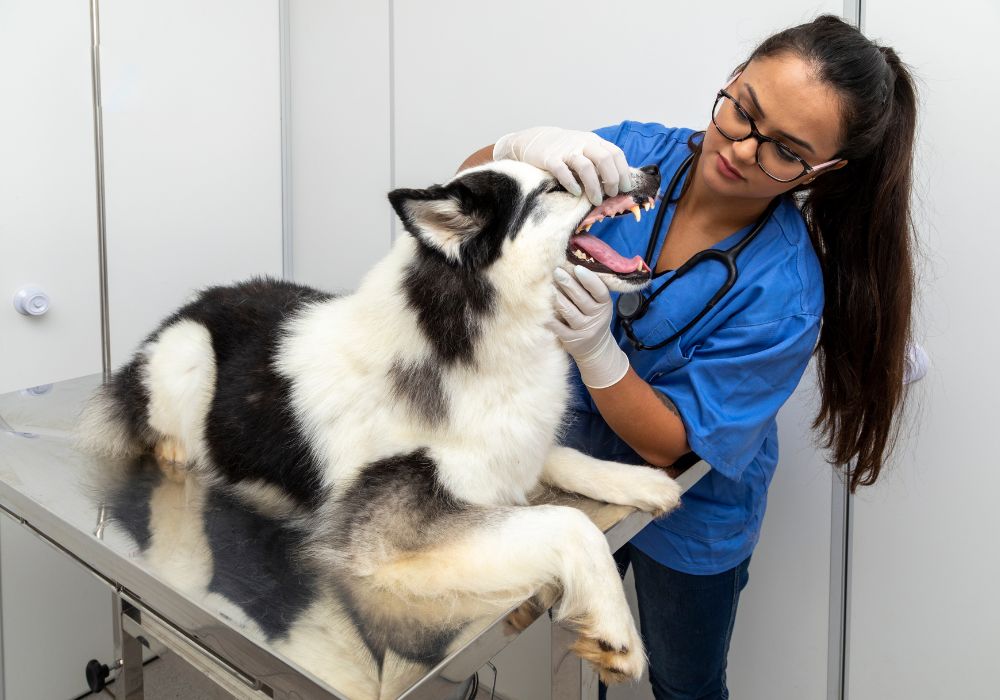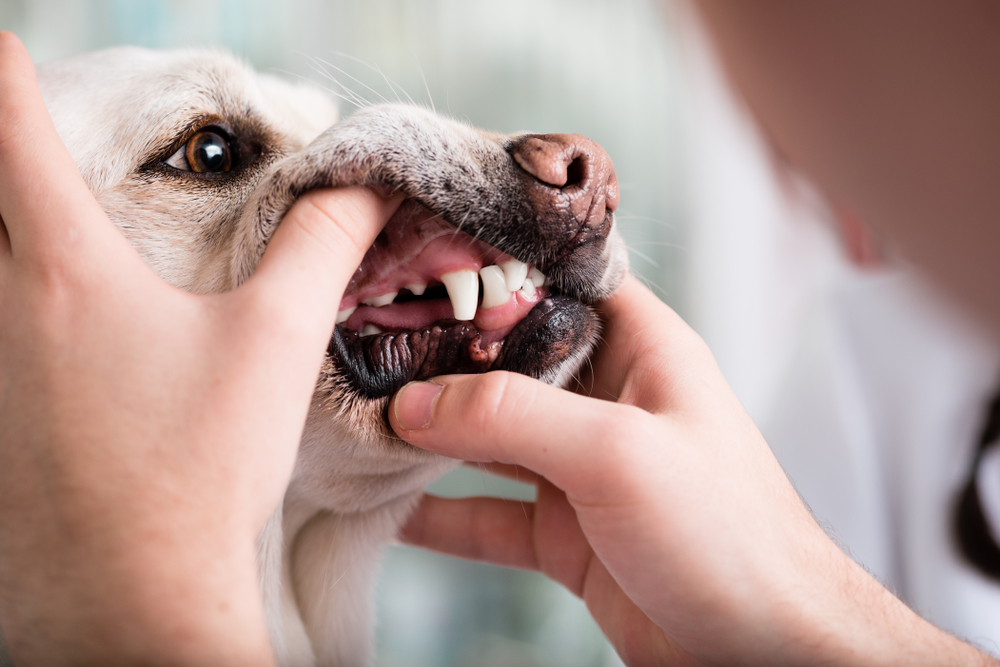A dog’s dental health isn’t something we usually think about when adopting a new pet. Yet, it’s incredibly important. Dog’s teeth are as susceptible to tartar buildup as our own teeth and they can develop the exact same infections, periodontal disease issues, tooth decay, and other problems that people have. What’s worse, because dogs are so well-mannered – and also have no clue that dental care is even a possibility – they tend to hide the pain and can often live with it for years without us even knowing.
So, what’s the solution? It’s the same as it is for people – proper maintenance. If you simply make sure that your dog’s mouth and teeth are well taken care of at all times, you’ll minimize the risk of dental disease and gum disease by an astronomical degree – so much so that not only are tooth decay and tooth loss not going to be a significant risk but even something as simple as bad breath will stop being an issue.
So, how to remove plaque from a dog’s teeth? This may sound like an overly complicated and unmanageable task but you’ll be surprised at how easy it actually is to take care of your dog’s teeth if you approach the issue the right way.
How to Remove Plaque from A Dog’s Teeth?
Unfortunately, there isn’t some magical and secret canine-friendly method for removing plaque from a dog’s teeth. Just as with our dental cleaning options, the best way to clean the teeth of your pet is to grab the toothpaste and toothbrushes and put some elbow grease into it.
Still, don’t despair – there are other things to try too if you really don’t want to brush your dog’s teeth and gums. We’ll list those below too but we will start with an overview of dog teeth brushing as that is indeed the best way to deal with plaque, prevent bacteria infections, and so on.
#1. Brushing your dog’s teeth
A lot of dog owners immediately wince at the concept of brushing their dog’s teeth but this can actually be much easier than it sounds if you approach the whole endeavor the right way. The trick, as with everything else we do with our pets, is in the proper training of the dog.
Dogs are creatures of habit, after all, so, once you make brushing something they are used to and enjoy, you should be able to do so easily for years to come. So, how can you do that first part and get your dog to enjoy, or at least tolerate, toothbrushing? Here’s a step-by-step guide:
- Get your dog familiar with the toothbrush without using it as intended at first. This is a simple step and it’s the same as what we do with the dog nail clippers before we start using them – just put the toothbrush somewhere the dog will see it and let the pooch accept it as just another ordinary household object that doesn’t present any danger.
- Get your dog used to the taste of the toothpaste. How easily this happens will depend on the dog as different animals have different tastes. Most dogs don’t appreciate the taste of mint, however, dog-specific kinds of toothpaste – which you should use as those have the right taste and ingredients for a dog – can have varying tastes.
Proper dog toothpaste should also be approved by the Veterinary Oral Health Council or VOHC. So, if your dog is food-motivated, you should be able to find a toothpaste it enjoys – if not right away, then after 2-3 tries. Once you do, simply present some of the paste as a treat, it is safe for a dog to swallow. - The last of these “prep” steps is to get your dog used to having its mouth, nose, lips, and teeth handled. This may already be the case for your dog but if it isn’t – just start doing this gently and reward your dog every time with a treat until it gets used to having its muzzle handled.
- Once you’ve repeated the above three steps for several days, your dog should be fully on board with having its mouth touched, with the taste of the dog toothpaste, and with the toothbrush as an item. So, when you think the situation is appropriate, simply put some toothpaste on the brush, and gently start brushing it on your dog’s teeth.
- You don’t need to do a “proper” brushing on the first go as your dog will likely still be a bit confused and resistant. So, it’s ok if the first brushings are not overly extensive and long – you can gradually start making them longer and longer as your dog gets used to the process.
If you want a visual presentation of how all this is supposed to go down, we have a video above shows how it’s done. As for how often you’ll need to brush your dog’s teeth – that will depend on your vet’s recommendation and on whether it’s just for prevention or your dog has already developed a dental issue that needs to be fixed and maintained.
#2. Dog dental wipes do work

Another maintenance method a lot of people gravitate towards instead of brushing is just using dog dental wipes. These often seem like an easier and simpler alternative to brushing but, unfortunately, wipes just aren’t as good at proper dental maintenance as brushing.
They can be used to remove some light tartar build-up from the top of the teeth but you’ll usually just remove lots of saliva and not enough tartar – especially not from the hard-to-reach places near the gums and between the teeth – for those you would need a toothbrush.
#3. Chew toys that can help
Using a good dental chew toy that your dog enjoys playing with and chewing on is indeed a great method for dental maintenance and prevention. Such chew toys can be great fun for your dog while also removing lots of plaque build-up from your dog’s teeth.
Do keep in mind that such chew toys aren’t a complete replacement for brushing, however – like dental wipes, they will just remove some of the plaque from the easy-to-reach places. So, you’d still want to reach for the toothpaste and the toothbrush if you want your dog to have healthy and clean teeth.
The reason chew toys are usually recommended whereas dental wipes aren’t is that the former are at least fun for the dog and don’t need a hands-on approach from you. Dental wipes, on the other hand, are just a lot of hassle and are no fun for either party.
#4. The type of dog foods you use matters
Dog teeth cleaning can also be assisted by using the right types of food. Veggies such as carrots are great for dog teeth cleaning, for example, as they just remove a lot of the plaque buildup as your dog is chewing on them. The same goes for raw bones, although you should be careful with the type of bone you’re using as some can splinter and get stuck in your dog’s threat. Raw bones are still much safer than cooked bones, of course, as the latter splinter off much more easily.
Again, as we said in regard to chew toys, this cleaning potential of bones and veggies is great and is comparable to that of dental wipes but isn’t a replacement for a good old-fashioned toothbrush with toothpaste.
#5. Dental treats can help too
Like with the previous two points, there are special types of dog dental treats that are also great at scraping down some of the tartar buildups from your dog’s teeth. Such treats can come in all shapes and sizes, and with various tastes, so, you can always find something your dog will enjoy. Still, again, such treats aren’t a replacement for just brushing your dog’s teeth, just as they wouldn’t be a replacement for us brushing our own teeth.
In Conclusion – Why Taking Care of Your Dog’s Oral Health is Important?
It’s easy to ignore a dog’s dental needs as they don’t speak up when their teeth hurt. However, dog toothbrushing isn’t just something veterinarians have made up – ignoring your pet’s dental health can be as detrimental to the dog’s overall health as it would be for us. Dental issues can easily lead to not only toothache and tooth decay but to bone issues, kidney problems, neurological concerns, diabetes, heart disease, and many other things vets constantly warn us about.
Fortunately, avoiding all of those is easy once you get the hang of it. In fact, if you do it right, the toothpaste can become your dog’s favorite treat.

